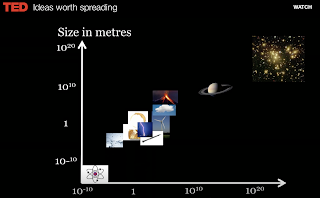 |
When I think about the size of something I think in a frame of reference of a human being. Yeah, sounds funny, but I can think in other frames of reference but it is a weird trick I have to play in my mind to do that. Like switching the foreground and background in one of those pictures of the old and young ladies.
So what is the Human Scale? What's the smallest a person can typically see, something we see and really have a sense of the size of it? A grain of salt is about the smallest. That's about one-half mil-meter (10^-4 X 5m). And the largest, I say something like an oak tree 20 meters (10^1 X 2m).
Can I really get a sense of a Redwood Tree at 110 meters (10^2 X 1.1m) or the Eiffel Tower at 320 meters (10^2 X 3.2m)? I've been to Paris and standing near the tower there is no sense of how large it really is. Only from many blocks away do you feel like you can take it all in, but then you have only a vague idea of what makes the tower, the steel and bolts.
But how big is the solar system, and what's the size of our galaxy? Or what is the size of a electron shell in the carbon atom?
Well, I've found that there is a word for this 'human scale of perception' in this wonderful mind expanding TED talk by David Eagleman. The word is "umwelt" - the German word for the surrounding world.
Can we create new senses for humans?
Watch Eagleman's TED talk for a chance to expand your personal umwelt. Technology will and does expand our umwelt - there are many people with low tech augmentations, eyeglasses, hearing aids, walking canes; and these augmentations are getting much higher-tech... and the mind is very plastic and will accept many types of data - we just need to plug it in (PH model of Evolution). The sensory substitution has been happening since 1969. Is the vibration of the cell phone in your pocket just a very simple signal of feeling the umwelt that someone is wanting your attention. Would you like to expand this capability?
Here are two wonderful visualizations that help us change our human frame of reference and feel like we can imagine outside our small human scale of only 5 orders of magnitude.
Scale of Universe an interactive tool (flash)
 "Powers of Ten takes us on an adventure in magnitudes. Starting at a picnic by the lakeside in Chicago, this famous film transports us to the outer edges of the universe. Every ten seconds we view the starting point from ten times farther out until our own galaxy is visible only as a speck of light among many others. Returning to Earth with breathtaking speed, we move inward- into the hand of the sleeping picnicker - with ten times more magnification every ten seconds. Our journey ends inside a proton of a carbon atom within a DNA molecule in a white blood cell."
"Powers of Ten takes us on an adventure in magnitudes. Starting at a picnic by the lakeside in Chicago, this famous film transports us to the outer edges of the universe. Every ten seconds we view the starting point from ten times farther out until our own galaxy is visible only as a speck of light among many others. Returning to Earth with breathtaking speed, we move inward- into the hand of the sleeping picnicker - with ten times more magnification every ten seconds. Our journey ends inside a proton of a carbon atom within a DNA molecule in a white blood cell."
Assume the 1 stands for one meter... what's the human scale?
Helen Czerski encourages us to play with toys to understand the physics in the middle (human scaled) region.
Physics doesn't just happen in a fancy lab -- it happens when you push a piece of buttered toast off the table or drop a couple of raisins in a fizzy drink or watch a coffee spill dry. Become a more interesting dinner guest as physicist Helen Czerski presents various concepts in physics you can become familiar with using everyday things found in your kitchen.
Just (August 2023) saw this article from BigThink about the 13 "scales" that define our Universe. They start at the subatomic level and zoom out to the Galatic scales. An enjoyable read.



Comments
Reminds me of the tongue-in-cheek unit of measurement known by MITers as a "Smoot".
http://en.wikipedia.org/wiki/Smoot.